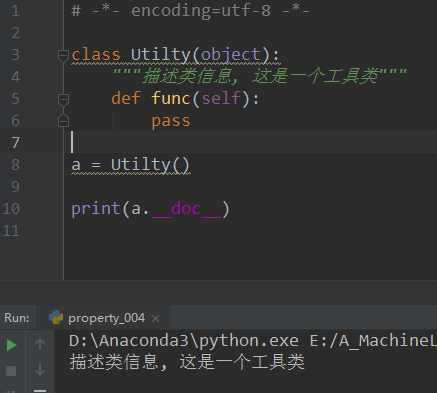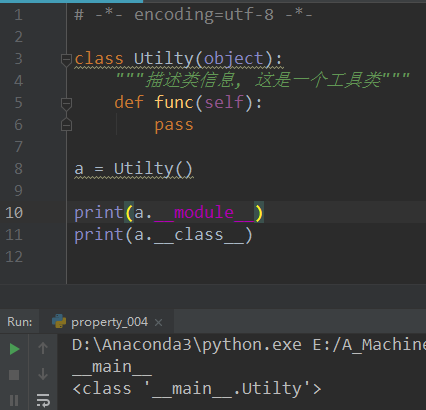1. 私有属性 名字重整

print(Test.__dict__)
{'__weakref__': <attribute '__weakref__' of 'Test' objects>, '__init__': <function Test.__init__ at 0x00000000010C59D8>, '__doc__': None, '__dict__': <attribute '__dict__' of 'Test' objects>, '__module__': '__main__'}
2. 魔法属性
2.1 __doc__
- 表示类的描述信息

2.2 __module__和 __class__
-
__module__: 表示当前操作的对象在哪个模块
-
__class__: 表示当前操作的对象的类是什么

2.3 __init__
- 初始化方法,通过类创建对象时,自动触发执行
2.4 __del__
-
当对象在内存中被释放时,自动触发执行
-
注:此方法一般无需定义,因为Python是高级语言,程序员无需关系内存的分配和释放,因此工作都是交给Python解释器来执行,所以,__del__的调用是 由解释器在进行垃圾回收时自动触发执行的。
2.5 __call__
- 对象后面加括号,触发执行
注意:__init__方法的执行是由创建对象触发的,即:对象 = 类名();而对于 __call__ 方法的执行是由对象后加括号触发的,即:对象() 或者 类()()
# -*- encoding=utf-8 -*- class Foo(object): def __init__(self): pass def __call__(self, *args, **kwargs): print("__call__") c = Foo() c() Foo()()

2.6 __dict__
- 类或对象中的所有属性
类的实例属性属于对象; 类中的类属性和方法等属于类
# -*- encoding=utf-8 -*- class Foo(object): country = "douzi" def __init__(self, name, count): self.name = name self.count = count def func(self, *args, **kwargs): print("func") # 获取类的属性,即:类属性,方法 print(Foo.__dict__) # 获取对象obj1的属性 obj1 = Foo("test", 134) print(obj1.__dict__)
{'__dict__': <attribute '__dict__' of 'Foo' objects>, '__module__': '__main__', '__weakref__': <attribute '__weakref__' of 'Foo' objects>, '__doc__': None, 'func': <function Foo.func at 0x000000000A538378>, 'country': 'douzi', '__init__': <function Foo.__init__ at 0x00000000010E59D8>}
{'count': 134, 'name': 'test'}
2.7 __str__
- 如果一个类中定一个 __str__方法,那么在打印对象时,默认输出该方法的返回值
class Foo(object): def __str__(self): return "douzi" t = Foo() print(t)
douzi
2,8 __getitem__、__setitem__、__delitem__
- 用于索引操作,如字典。以上分别表示获取、设置、删除数据
- 表示实现了该三个方法,该类即当列表用
class Foo(object): def __getitem__(self, item): print("__getitem__:", item) def __setitem__(self, key, value): print("__setitem__:", key, value) def __delitem__(self, key): print("__delitem__:", key) obj = Foo() res = obj["k1"] # 自动触发执行 __getitem__ obj["k2"] = "douzi" # 自动触发执行 __setitem__ del obj["k1"] # 自动触发执行 __delitem__

2.9 __getslice__、__setslice__、__delslice__
- 该三个方法用于分片操作,如:列表
class Foo(object): def __getslice__(self, i, j): print("__getslice__:", i, j) def __setslice__(self, i, j, sequence): print("__setslice__:", i, j, sequence) def __delslice__(self, i, j): print("__delslice__:", i, j) obj = Foo() obj[0:2] obj[0:2] = [11, 22, 33, 44] del obj[0:2]
